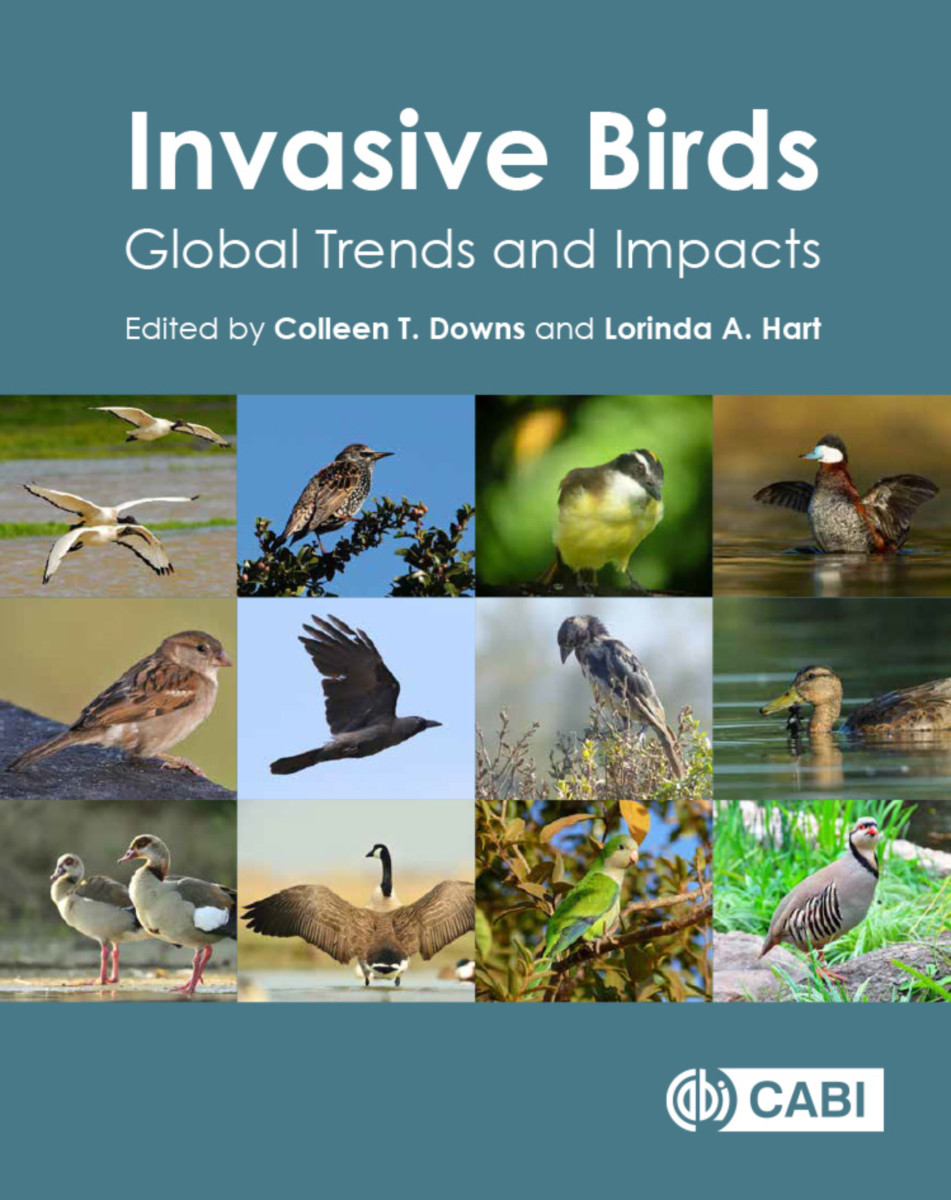Invasive Birds
Global Trends and Impacts
- Publisher
CABI - Published
31st December 2020 - ISBN 9781789242065
- Language English
- Pages 384 pp.
- Size 8" x 10"
- Images color photos & maps
Examining globally invasive alien birds, the first part of this book provides an account of 32 global avian invasive species (as listed by the Invasive Species Specialist Group, ISSG). It acts as a one stop reference volume; it assesses current invasive status for each bird species, including details of physical description, diet, introduction and invasion pathways, breeding behavior, and natural habitat. It also looks at the environmental impact of each species, as well as current and future control methods. Full color photographs assist with species identification and global distribution maps give a visual representation of the current known distributions of these species.
The second part of the book discusses the biogeographical aspects of avian invasions, highlighting current and emerging invasive species across different regions of the world. The third section considers the impact of invasive species on native communities, problems associated with invasive bird management and the use of citizen science in the study of invasive birds.
" Enhanced with a full listing of the contributors and their credentials, Invasive Birds: Global Trends and Impacts, collaboratively compiled and co-edited by Colleen T. Downs and Lorinda A. Hart, also features illustrations, an informative introduction, and a nine page index. An ideal and unreservedly recommended addition to professional, governmental, college, and university library Ecology and Zoology collections in general, and Ornithology supplemental curriculum studies lists in particular, it should be noted for the personal reading lists of students, ornithologists, and non-specialist general readers with an interest in the subject."
Library Bookwatch
Section 1: Introduction
1: Introduction
2: Common Starling (Sturnus vulgaris Linnaeus, 1758)
3: Common Myna (Acridotheres tristis Linnaeus, 1766)
4: Jungle Myna (Acridotheres fuscus Wagler, 1827)
5: Red-vented Bulbul (Pycnonotus cafer Linnaeus, 1766)
6: Red-whiskered Bulbul (Pycnonotus jocosus Linnaeus, 1758)
7: Great Kiskadee (Pitangus sulphuratus Linnaeus, 1766)
8: Red-billed leiothrix (Leiothrix lutea Scopoli, 1786)
9: Ring-necked Parakeet (Psittacula krameri Scopoli, 1769)
10: Monk Parakeet (Myiopsitta monachus Boddaert, 1783)
Section 2: Global avian invaders (as listed by ISSG)
11: House Sparrow (Passer domesticus Linnaeus, 1758)
12: Shiny Cowbird (Molothrus bonariensis Gmelin, 1788)
13: Brown-headed Cowbird (Molothrus ater Boddaert, 1783)
14: Rock Dove (Columba livia Gmelin, 1789)
15: Eurasian Collared-dove (Streptopelia decaocto Frivaldszy, 1838)
16: Chukar Partridge (Alectoris chukar Gray, 1830)
17: Cattle Egret (Bubulcus ibis Linnaeus, 1758)
18: Red Junglefowl (Gallus gallus Linnaeus, 1758), Grey Junglefowl (Gallus sonneratii Temmink, 1813) and Green Junglefowl (Gallus varius Shaw, 1798)
19: House Finch (Carpodacus mexicanus Müller, 1776)
20: Common Waxbill (Estrilda astrild Linnaeus, 1758)
21: Scaly-breasted Munia (Lonchura punctulata Linnaeus 1758)
22: Northern Red Bishop (Euplectes franciscanus Isert 1789)
23: Warbling White-eye (Zosterops japonicus Temminck and Schlegel 1845)
24: House Crow (Corvus splendens Vieillot, 1817)
25: Australian Magpie (Gymnorhina tibicen Latham, 1802)
26: Mallard (Anas platyrhynchos Linnaeus, 1758)
27: Ruddy Duck (Oxyura jamaicensis Gmelin, 1789)
28: Egyptian Goose (Alopochen aegyptiaca Linnaeus, 1766)
29: Greylag Goose (Anser anser Linnaeus, 1758)
30: Canada Goose (Branta canadensis canadensis Linnaeus, 1758)
31: Mute Swan (Cygnus olor, Gmelin, 1789)
32: Gray-headed Swamphen (Porphyrio poliocephalus Latham, 1801)
33: African Sacred Ibis (Threskiornis aethiopicus Latham, 1790)
34: Great Horned Owl (Bubo virginianus Gmelin, 1788)
35: Swamp Harrier (Circus approximans Peale, 1848)
Section 3: Avian invaders’ biogeography and emerging invasive species
36: Continental analysis of invasive birds: Australia and New Zealand
37: Continental analysis of invasive birds: Africa
38: Continental analysis of invasive birds: North America
39: Continental analysis of invasive birds: South America
40: Continental analysis of invasive birds: Europe and the Middle East
41: Continental analysis of invasive birds: Asia
Section 4: Impacts and management
42: Competition between invasive and native bird species
43: Control or eradication: problems in the management of invasive birds
44: Using citizen science to study exotic and invasive birds
Section 5: Conclusion
45: Conclusions
Colleen T. Downs
Prof. Colleen T. Downs is a South African Research Chair and has been based at the University of KwaZulu-Natal since 1994. Her research interests are broad and interdisciplinary, spanning the conservation, ecology, physiology and behavior of terrestrial vertebrates with changing land use. This includes ecosystem health in KwaZulu-Natal, incorporating conservation, general biology and persistence of mammal, herpetological and bird species with changing land use (including urban ecology). There is a focus on species such as Cape parrots, bushbuck, oribi, pelicans, Cape vultures, Nile crocodiles, fruit bats, raptors, small carnivores and feral cats. Her other key contribution has been in the development of increased research capacity at both undergraduate and postgraduate levels. Her research group is currently investigating ecosystem health and functionality across a range of taxa and biomes in the Eastern Cape and KwaZulu-Natal Provinces of South Africa, with a focus on species distributions, persistence and anthropogenic threats. They have also produced recommendations for conservation and landscape managers on how best to preserve ecosystem functionality based on sound ecological research.
Lorinda A. Hart
Dr. Lorinda A. Hart is a post-doctoral research fellow at the University of KwaZulu-Natal. Her research interests are broad, covering ecophysiology, and urban and invasive ecology. Her PhD focused on avian and bat frugivores which feed on invasive fruits commonly found in South Africa, quantifying the effects that these frugivores have on invasive seed germination and the energetic rewards they gain. After her PhD she conducted public surveys and determined the current distribution of the rose-ringed parakeet in the greater Durban Metropolitan area of eThekwini. She is currently involved in several projects examining a range of species including fruit bats, birds of prey, woolly-necked storks and a variety of seabirds from the Seychelles. She is also an invasive species consultant with the South African Green Industries Council (SAGIC).


